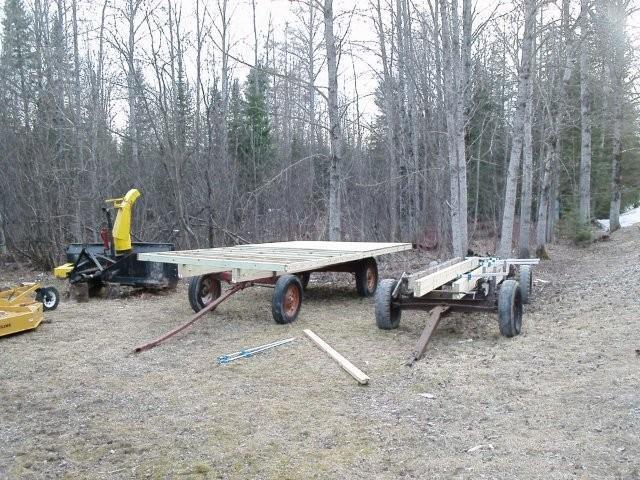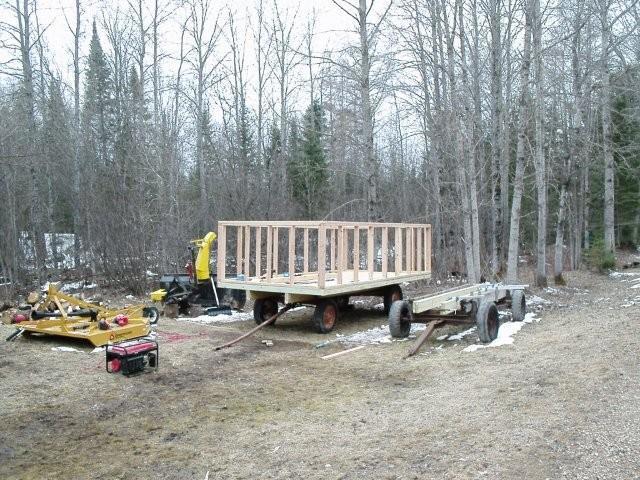Navigation
Install the app
How to install the app on iOS
Follow along with the video below to see how to install our site as a web app on your home screen.
Note: This feature may not be available in some browsers.
More options
You are using an out of date browser. It may not display this or other websites correctly.
You should upgrade or use an alternative browser.
You should upgrade or use an alternative browser.
Pastured Cornish Cross Via Mobile Hen House Query
- Thread starter TDM
- Start date
- Thread starter
- #12
Quote:
I buy the running gears for $100. Then I build the structures myself for about $800 in materials and $400 in labor. I figure a minimum 20 year lifespan, so that is about $65 per year depreciation. I have 65 layers per house, which produce about three to four dozen eggs per day. Figuring that each house produces 1,300 dozen eggs per year, that is a housing cost of $0.05 per dozen.
My eggs sell through the stores at $3.69 per dozen, and I get 70% of that. My eggs are true pasture, and not somebody's version of letting their bird have 10 square feet of a barren dirt run space and calling it free range.
There are eight 100 ft panels that make up the electric netting. At $180 per panel along with an energizer, battery and solar panel, that is about $1,600 in cost. The fence is expected to have a 10 year life, with batteries being a replaceable item. This $1,600 is spread out over 10 years at 2,600 dozen eggs per year. That is about another $0.06 charged against a dozen eggs for fencing.
I buy the running gears for $100. Then I build the structures myself for about $800 in materials and $400 in labor. I figure a minimum 20 year lifespan, so that is about $65 per year depreciation. I have 65 layers per house, which produce about three to four dozen eggs per day. Figuring that each house produces 1,300 dozen eggs per year, that is a housing cost of $0.05 per dozen.
My eggs sell through the stores at $3.69 per dozen, and I get 70% of that. My eggs are true pasture, and not somebody's version of letting their bird have 10 square feet of a barren dirt run space and calling it free range.
There are eight 100 ft panels that make up the electric netting. At $180 per panel along with an energizer, battery and solar panel, that is about $1,600 in cost. The fence is expected to have a 10 year life, with batteries being a replaceable item. This $1,600 is spread out over 10 years at 2,600 dozen eggs per year. That is about another $0.06 charged against a dozen eggs for fencing.
Last edited:
- Jun 15, 2008
- 1,450
- 39
- 171
How much pasture land do you have ? What is it's fair market value and property taxes ? since you can't depreciate land, what do you attribute to rent that has to be charged to production costs?
Quote:
I buy the running gears for $100. Then I build the structures myself for about $800 in materials and $400 in labor. I figure a minimum 20 year lifespan, so that is about $65 per year depreciation. I have 65 layers per house, which produce about three to four dozen eggs per day. Figuring that each house produces 1,300 dozen eggs per year, that is a housing cost of $0.05 per dozen.
My eggs sell through the stores at $3.69 per dozen, and I get 70% of that. My eggs are true pasture, and not somebody's version of letting their bird have 10 square feet of a barren dirt run space and calling it free range.
There are eight 100 ft panels that make up the electric netting. At $180 per panel along with an energizer, battery and solar panel, that is about $1,600 in cost. The fence is expected to have a 10 year life, with batteries being a replaceable item. This $1,600 is spread out over 10 years at 2,600 dozen eggs per year. That is about another $0.06 charged against a dozen eggs for fencing.
You are able to build those much cheaper than I would have assumed. I'd pay you $1300 to build one of those for me!!! Heck, make it $1,500 to cover travel expenses
 . They do look nice.
. They do look nice.
I buy the running gears for $100. Then I build the structures myself for about $800 in materials and $400 in labor. I figure a minimum 20 year lifespan, so that is about $65 per year depreciation. I have 65 layers per house, which produce about three to four dozen eggs per day. Figuring that each house produces 1,300 dozen eggs per year, that is a housing cost of $0.05 per dozen.
My eggs sell through the stores at $3.69 per dozen, and I get 70% of that. My eggs are true pasture, and not somebody's version of letting their bird have 10 square feet of a barren dirt run space and calling it free range.
There are eight 100 ft panels that make up the electric netting. At $180 per panel along with an energizer, battery and solar panel, that is about $1,600 in cost. The fence is expected to have a 10 year life, with batteries being a replaceable item. This $1,600 is spread out over 10 years at 2,600 dozen eggs per year. That is about another $0.06 charged against a dozen eggs for fencing.
You are able to build those much cheaper than I would have assumed. I'd pay you $1300 to build one of those for me!!! Heck, make it $1,500 to cover travel expenses

- Thread starter
- #15
Quote:
I rent the land at $10 per acre. Some people let me on a field for a couple weeks if I just brush cut it for them. Two mobile hen houses consume 1 acre of land every two weeks. I can double back during the summer after the pasture recovers. Fortunately it knocks my grain costs down and increases the value/marketability of my eggs.
I'm nothing more than a tenant/gypsy chicken farmer.
I rent the land at $10 per acre. Some people let me on a field for a couple weeks if I just brush cut it for them. Two mobile hen houses consume 1 acre of land every two weeks. I can double back during the summer after the pasture recovers. Fortunately it knocks my grain costs down and increases the value/marketability of my eggs.
I'm nothing more than a tenant/gypsy chicken farmer.
Last edited:
- Thread starter
- #16
FYI - Joe Salatin didn't name that chicken tractor after himself at all. He is featured on Food, Inc and another documentary covering the way our food is made or raised. He raises his chickens the same way you do and uses the same type of tractors. Except that he runs cattle and pigs on the very same pasture, rotating the three types of livestock and letting the ground rest after the pigs or something, depending on time of year. People started calling the tractors Salatin inspired because that is the first place many of us saw them.
Were I to raise chickens commercially on acreage I'd use those too. Yours are really nice looking with that "red barn" look!
Were I to raise chickens commercially on acreage I'd use those too. Yours are really nice looking with that "red barn" look!
- Thread starter
- #18
Quote:
People are more receptive to letting you on your land if it doesn't look like junk operation. Good advertising.
Me at the last July 4th parade:

People are more receptive to letting you on your land if it doesn't look like junk operation. Good advertising.
Me at the last July 4th parade:

- Jun 15, 2008
- 1,450
- 39
- 171
Quote:
I rent the land at $10 per acre. Some people let me on a field for a couple weeks if I just brush cut it for them. Two mobile hen houses consume 1 acre of land every two weeks. I can double back during the summer after the pasture recovers. Fortunately it knocks my grain costs down and increases the value/marketability of my eggs.
I'm nothing more than a tenant/gypsy chicken farmer.
So, where do they stay the rest of the year ?
I rent the land at $10 per acre. Some people let me on a field for a couple weeks if I just brush cut it for them. Two mobile hen houses consume 1 acre of land every two weeks. I can double back during the summer after the pasture recovers. Fortunately it knocks my grain costs down and increases the value/marketability of my eggs.
I'm nothing more than a tenant/gypsy chicken farmer.
So, where do they stay the rest of the year ?
- Thread starter
- #20
Quote:
From the end of October through April the wagons are corralled on a small rural plot of land near my house. Each of the four mobile hen houses is insulated and acts as stand alone chicken coop. I use solar panels and batteries to aid in providing 16 hours of light to keep egg production up. A 50' x 50' area of land in the center is kept clear for an exercise run using a snowblower .
I also make money in the winter providing snow removal services, as you may have guessed.
I have to keep them close because here in upper Michigan we can get our secondary roads closed down for days at a time.

From the end of October through April the wagons are corralled on a small rural plot of land near my house. Each of the four mobile hen houses is insulated and acts as stand alone chicken coop. I use solar panels and batteries to aid in providing 16 hours of light to keep egg production up. A 50' x 50' area of land in the center is kept clear for an exercise run using a snowblower .
I also make money in the winter providing snow removal services, as you may have guessed.
I have to keep them close because here in upper Michigan we can get our secondary roads closed down for days at a time.

Last edited:
New posts New threads Active threads
-
Latest posts
-
-
-
Dreaming of Spring Gardening in the Middle of a Wisconsin winter part 2
- Latest: Callender Girl
-
-
-
Latest threads
-
-
-
Regrets on Coffee grounds as bedding?
- Started by RoxieChick27
- Replies: 1
-
-
NEED HELP! MY HEN IS ACTING UNUSUAL UPDATE!!
- Started by chicken tender lady
- Replies: 5
-
-
Threads with more replies in the last 15 days
-
Finally having my first proper hatch along! Astronomy theme 🪐✨
- Started by Cheekychook12
- Replies: 127
-
-
-
-
Has impaction turned sour crop but is still hungry and energetic?
- Started by Ccort
- Replies: 72
-
×









